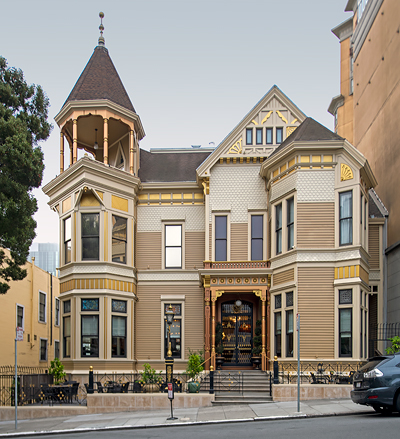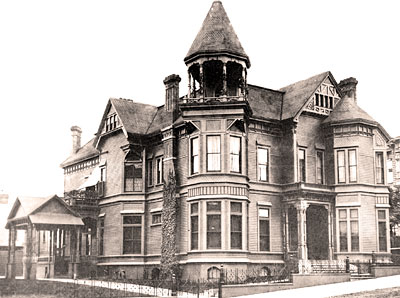National Register of Historic Places in San Francisco
Theodore F. Payne Residence
1409 Sutter Street
Built 1881
The Payne House is the last of a number of large homes which stood on Sutter between Franklin and Gough. Its importance may be found in its architecture, in the role of the Payne family in early San Francisco history, and in William Curlett, its architect.
Designed by architect William F. Curlett, the house is a dignified combination of earlier Victorian styles such as Eastlake and Stick and the later Queen Anne Style with an emphasis on spaciousness and openness.
The building was designed to include the most advanced plumbing, central heating, machine-made hardware, and materials of the day. The toilet rooms were fully integrated into the house and not just hung on a porch or verandah - an intermediate step between the back yard privy and a modern bathroom. Lavatories and tubs had hot and cold running water.
The Payne House is one of the few examples of virtually unchanged pre-fire homes of San Francisco's wealthier class. It is a reminder of an adolescent city built of wood by California gold and Comstock silver. The 1906 Earthquake and Fire was the turning point. The main commercial district of the rebuilt city soon scaled the nabobs' bastion, Nob Hill, and grew westward to Van Ness Avenue. Only a few of the homes of San Francisco's rich remain in this area.
By the time the house was built, the Payne family had been established as people of importance in San Francisco. In fact, Payne wealth and influence had roots in the first years of the California Gold Rush.
The house was built for Theodore Payne's son, Theodore F. Payne, and his wife, Mary Pauline, who had the good fortune of being the niece of a very wealthy man. Her unmarried uncle, William S. O'Brien, one of the Comstock Silver Kings, had at the time of this death amassed a fortune from the Great Bonanza, the fabulously rich Consolidated-Virginia Mine in Virginia City, Nevada.
O'Brien did not live long to enjoy his fortune. He passed away on May 2, 1878, about the time bonanza ore from the Consolidated-Virginia ran out and the mine and Virginia City entered its final decline, marking the end of San Francisco and Virginia City's intimate connection of two decades.
Mary Pauline received more than twice as much as any other heir which made her a very wealthy woman. One can safely conclude that Comstock silver paid for the Payne House and the lot it stands on, at least in part.
Adapted from the NRHP Nomination Form submitted in 1980.

When we photographed the Payne House it was home to the Mansion on Sutter Hotel.

